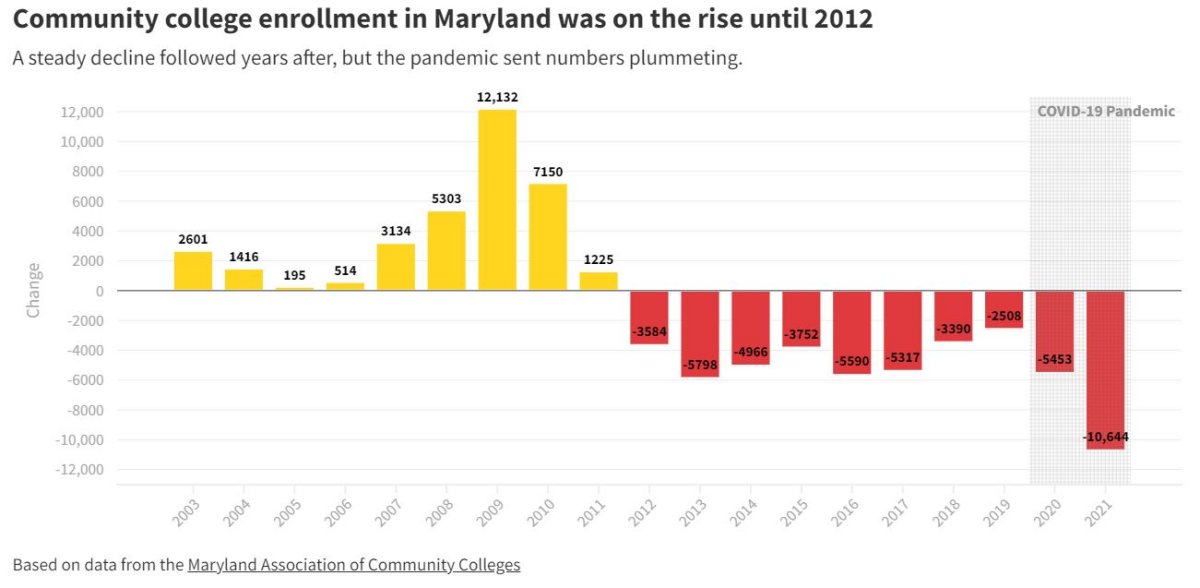COLLEGE PARK, Md. (April 19, 2022)—Undergraduate and graduate enrollment in public four-year universities has decreased during the pandemic and community college enrollment has seen an even more dramatic decline. As the pandemic led to financial uncertainty across the country and caused colleges to make changes to class delivery, student life and other services, students were enrolling at lower rates.
Historically, times of economic hardship result in increased enrollment in higher education in America, according to the National Bureau of Economic Research (NBER). At least since the 1980s recession, Maryland's public four-year institutions have generally followed this trend. However, during the COVID-19 pandemic, Maryland and the rest of the country saw a drastic decline in higher education enrollment.
During recessions, higher education enrollment generally increases as unemployment rates rise, according to the NBER. Teenagers and young adults especially gravitate toward college during economic hardship due to scarce employment opportunities.
When the COVID-19 pandemic hit, the country's economy entered a recession and unemployment spiked. Unlike previous economic downturns, college enrollment also declined drastically as classes moved online and students and their families faced financial uncertainty.
According to the National Student Clearinghouse Research Center (NSCRC), national undergraduate enrollment has seen an 8% drop since 2019.
The drop, however, is not out of the blue—college enrollment has been on the decline nationwide since 2011, according to NSCRC. Maryland's public four-year institutions deviated from this trend however; undergraduate enrollment only decreased two times between 2011 and 2019. In fact, 2014 saw a jump of over 9,000 undergraduate students. Graduate enrollment was on a very slight decline during that time.
In fall 2021, enrollment continued to decline. Unemployment dropped to pre-pandemic levels, and students started "questioning the value of college," said Doug Shapiro, the executive research director for NSCRC, in an interview with the Washington Post.
"They may be looking at friends who graduated last year or the year before who didn't go, and they seem to be doing fine. They're working; their wages are up," he said.
Despite an overall decline in enrollment in Maryland higher education, the changes varied among the state's public four-year institutions.
Within the University System of Maryland (USM), eight of the 11 universities saw a decline in undergraduate enrollment in the fall of 2020, and seven saw a decline the following year.
While undergraduate enrollment fell only slightly in fall of 2020, it dropped 3.44% in fall 2021. USM graduate enrollment deviated from the national trend by decreasing both years; they dropped more significantly in fall 2020 but had a smaller decline in fall 2021.
University of Maryland, Baltimore County (UMBC), saw a significant difference between undergraduate and graduate enrollment: while the number of undergraduate students dropped both years, the number of graduate students went up. In fall of 2021, graduate enrollment increased by 9.28%—the biggest uptick out of the 11 graduate schools.
UMBC Director of Communications and Content Strategy Dinah Winnick wrote in an email that "[d]espite the complications from the worldwide pandemic," students are applying to graduate school programs in "record numbers."
Other universities saw large declines in graduate enrollment. Salisbury University saw a 10.7% decline in graduate enrollment in 2021. Their undergraduate enrollment also fell, resulting in a 13% decrease overall since 2019.
Allen Koehler, Salisbury University's Assistant Vice President of Enrollment Management, said that this was a big hit for Salisbury, especially considering the 2020 fall cohort was a highly anticipated class for the university.
"The class that was for fall [2020], where COVID hit midway through the recruitment cycle, … was trending to be our largest class in over a decade," he said.
Community colleges have faced even worse declines during the pandemic. The pandemic worsened an existing trend, where community college enrollment was on the decline for years.
Nationwide, community college enrollment dropped by 10% in 2020, according to NSCRC. In 2021, it continued dropping but at a slower rate. In Maryland, community colleges saw the inverse: enrollment dropped slightly (4.8%) in 2020, with a much steeper decline (9.8%) in 2021.
After reaching a peak increase during the Great Recession, community colleges in Maryland began declining in 2012, which is in line with the national trend.
As the end of the 2021-22 school year approaches, the University System of Maryland Board of Regents will hold a meeting this month and discuss enrollment projections for the fall.
Higher education enrollment faced unprecedented drop during COVID-19 pandemic

Community college enrollment in Maryland was on the rise until 2012. A steady decline followed years after, but the pandemic sent numbers plummeting.


